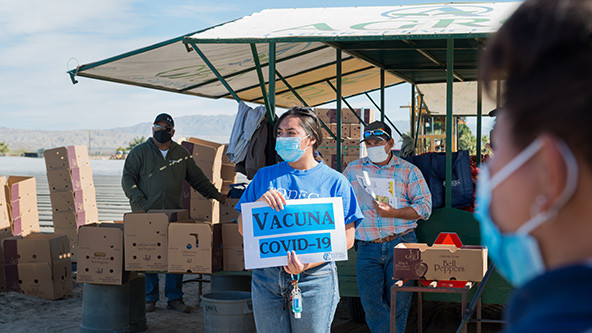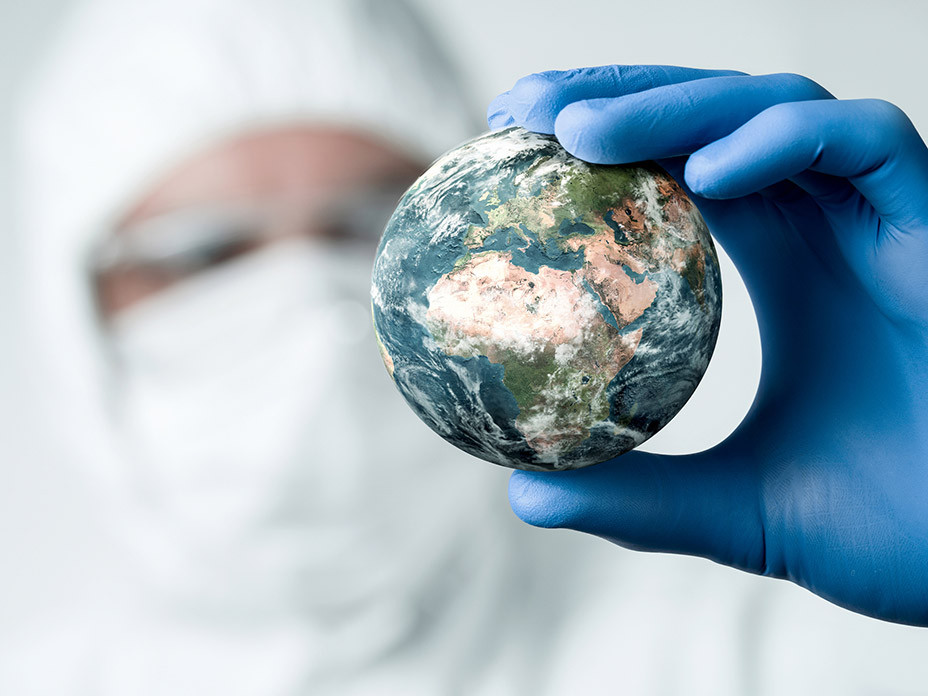 A mobile vaccination site in Coachella Valley, California, led by the immigrant-support organization TODEC and several local agencies, and in partnership with Riverside County and Together Toward Health. (Photo by Kathleen Hayden)
A mobile vaccination site in Coachella Valley, California, led by the immigrant-support organization TODEC and several local agencies, and in partnership with Riverside County and Together Toward Health. (Photo by Kathleen Hayden)
After nearly a year of living through the biggest public health crisis in generations—with 100 million people infected, 2 million people dead, and almost everyone’s lives disrupted—the world is desperate to see widespread vaccination against COVID-19. But the excitement of the Pfizer and Moderna vaccine approvals in December 2020 has since dampened after a rocky rollout to get those vaccines into people’s arms. It’s not enough to have a vaccine; it must be distributed effectively and equitably.
The good news is that vaccine distribution is picking up speed in many places. In the United States, President Biden has promised to invest significant federal dollars to provide states with the resources they need to vaccinate their residents. But this support will take time to secure and distribute while the need remains urgent. One barrier is significant rates of vaccine hesitancy rates, driven in part by a history of medical exploitation and mistreatment toward people of color in the United States. A recent study showed that just 14 percent of Black Americans and 34 percent of Latinx Americans trust that a COVID-19 vaccine will be safe.

Moments like this call for public-private partnership. In my role managing public-private partnerships for the Office of the Governor in California, I’ve seen throughout the COVID-19 pandemic that working together and leveraging the strengths of both sectors has created significantly more impact than working alone.
As we move into this new phase of attempting a historic mass-vaccination campaign in the United States, many in the philanthropic sector are eager to support the process in ways big and small. But given the unpredictable nature of the vaccination roll out, foundations and donors aren’t always sure how to leverage their investments most effectively.
While we still have much to learn as the process continues, the following are four ways philanthropy can effectively partner with governments now to support equitable vaccination distribution and ensure that more individuals are vaccinated against COVID-19:
1. Invest in Trusted Messengers
Experts say that as much as 90 percent of the population must achieve immunity to eliminate COVID-19, and yet public confidence in the vaccine—particularly among communities of color—falls far short of that. About a quarter of the public feels hesitant about the COVID-19 vaccine, meaning they say they probably or definitely will not get it. This is much higher among Black adults, with 35 percent saying they definitely will not get vaccinated.
We know that trusted messengers—well-respected community leaders who live and work in ethnic and racial minority communities disproportionately affected by the virus—are important to reaching vaccine-hesitant communities. However, community-based organizations like local health clinics or promotoras that often play that role aren’t always large enough to apply for state or local funding. Philanthropy can help fill that gap.
An unlikely example that provides a great playbook for what works is something unrelated to public health: the US Census. The country recently invested hundreds of millions of dollars building the capacity of a network of trusted messengers, to convince hard-to-reach populations to fill out the 2020 census. In California alone, state government and philanthropic partners worked together to fund hundreds of organizations that have close connections to groups like farmworkers, people with disabilities, and tribal communities—many of the same underrepresented communities that need information and support on vaccination.
One public-private partnership building on this model is Together Toward Health—a collaboration between the State of California, Public Health Institute, and a group of philanthropic funders led by The California Endowment. This $28 million fund is dedicated to funding organizations on the ground to do community education and outreach on COVID-19, including information on why and how to get vaccinated. The philanthropic funding is coordinated with a $30 million investment from the state to fund outreach and education, including through many of the same organizations that supported the state’s census efforts.
Investing in local grassroots organizations to support vaccine education isn’t just important to the success of vaccination efforts. By focusing on organizations led by people of color and other underrepresented leaders, who are well-positioned to reach vulnerable communities, we can also create more equity. Investment in these groups will help seed a new generation of leadership in the nonprofit sector and create an infrastructure for community-engagement that will last long after the COVID crisis.
2. Support Innovative Delivery of Vaccines
On the distribution of the vaccines, the state and the federal government will be playing the primary role. The Biden Administration has announced that the federal government will be setting up 100 vaccine mega-sites throughout the country, and states have been launching their own mass vaccination programs in sports arenas and other large venues. Hospitals, local health clinics, and health-care providers are acting as vaccine administrators, and community-based testing sites are converting some of their appointments to vaccine appointments.
But even these efforts aren’t enough; we need a wide range of innovative approaches. For example, one mobile vaccination site in Coachella Valley, California—led by the immigrant-support organization TODEC and several local agencies, and in partnership with Riverside County and Together Toward Health—vaccinated 250 agricultural workers in a single day. These workers received their vaccines during their shifts to avoid lost wages, and the site will return in three weeks to provide the second dose. Philanthropic funding supported staffing from eight local community-based organizations that helped lead the effort. Similar efforts are also taking a holistic approach to worker well-being by offering food distribution, COVID testing and education, as well as worker rights and tenant protection education.
We can also take learnings from distribution of the flu vaccine, where employers around the United States regularly provide easy ways for their employees to get vaccinated. We have also seen innovative pilots with schools. For example, an effective school-located influenza vaccination program called Shoo the Flu—fueled by a partnership between a county health department, a school district, and philanthropy—provided more than 55,000 vaccinations for preschools and elementary students and staff in 95 Northern Californian schools between 2014 and 2019. The impact of this city-wide program was significant, resulting in greater vaccination coverage, fewer school absences, and lower community-wide hospitalizations.
As vaccine supply becomes more available, philanthropy can support innovative pilots in partnership with schools, community health centers, collaboratives, and even companies (Uber, for example, has offered free and discounted rides to get people to vaccine sites). These efforts will help meet harder-to-reach communities where they are.
3. Support Job Training Programs for Community Health Workers
Philanthropy can also invest in training public health workers for immediate roles in contact tracing, community outreach, and education, as well as for longer-term careers in public health and health care. The United States has historically underinvested in its public health infrastructure, leaving an insufficient number of health care workers to address the pandemic. This, coupled with the fact that nearly 11 million Americans are currently unemployed, presents an ideal opportunity to both address COVID tracking and vaccination, and get people back to work.
The health care provider Kaiser Permanente is doing this through its partnership with the State of California. Through a grant to the Public Health Institute, it’s funding the hiring and training of 500 full-time workers—individuals who are linguistically and culturally competent, and who can support contact tracing work for the communities they serve. One example is John Franco. In 2020, Franco lost his job and then contracted COVID-19. A call from a contact tracer alerted him that he had been exposed to the disease, which stopped him from going to visit his mother the next day and spreading the virus to her. This experience inspired him to apply for the Kaiser Permanente program to become a contact tracer himself. He not only has served as a bilingual contact tracer for his community, but is now taking public health classes on the side and planning for a career in the field.
Similar efforts are sprouting up in other areas of the country too. In Chicago, for example, the Vaccine Corps Partnership is hiring community health workers to support the equitable distribution of vaccines, and Futuro Health is supporting online training for people interested in health-care careers. Innovations in workforce development to address COVID-19 and the economic crisis can move people from unemployment and despair to hope and new careers.
4. Invest in Coordination
Finally, we know that coordination at the national, state, and local levels will help bring more people to the table, and will ensure that we’re all leveraging each other’s strengths in this historic effort to vaccinate Americans.
One example is the COVID Collaborative—funded by the Skoll Foundation in partnership with the NAACP, UnidosUS, and Langer Research—which recently released results of a survey on vaccine hesitancy in Black and Latinx communities. Another is the Rockefeller Foundation’s State and Territory Alliance for Testing, which fosters collaboration among governors on testing and is helping develop best practices related to vaccines. At the local level, the Community Foundation in Monterey County is funding a weekly, facilitated conversation to ensure that local leaders are advancing a multi-sector, coordinated action plan to support public health and equity.
The reality is that we’re learning as we go when it comes to vaccine distribution. But while we still don’t fully know how our vaccination efforts will take shape, which interventions will reach the most people, or how we can be most efficient while still maintaining a focus on equity, philanthropy can act now to help government be more innovative in the process. This is the time to work together to get more vaccines in people’s arms and help bring this dark period of public health crisis to a close.
Support SSIR’s coverage of cross-sector solutions to global challenges.
Help us further the reach of innovative ideas. Donate today.
Read more stories by Kathleen Kelly Janus.

